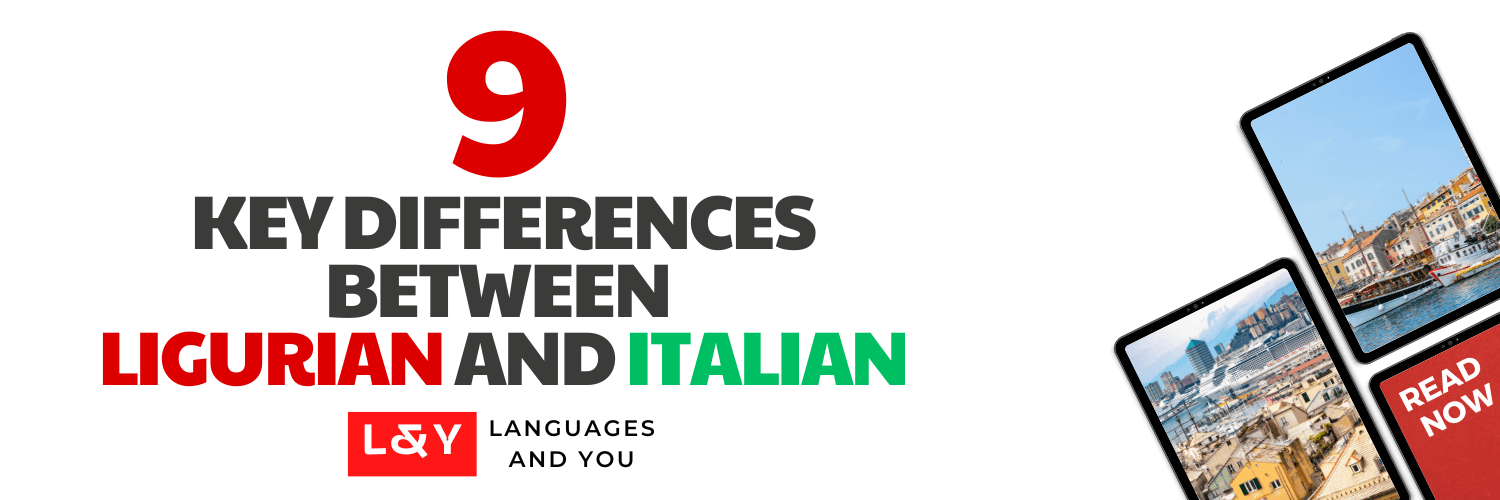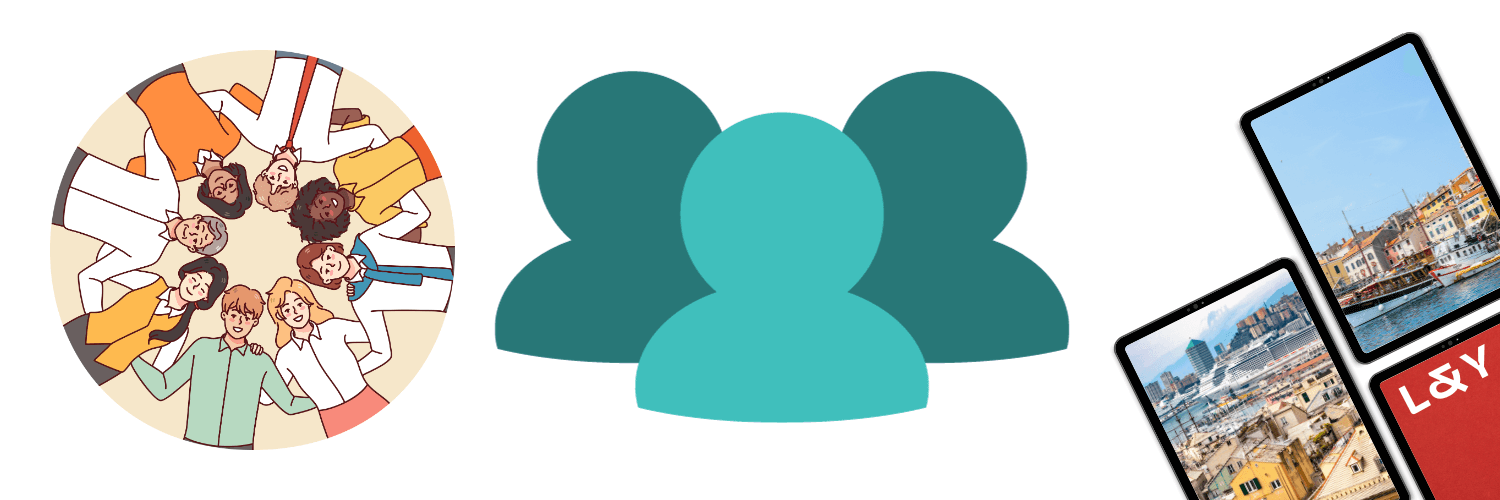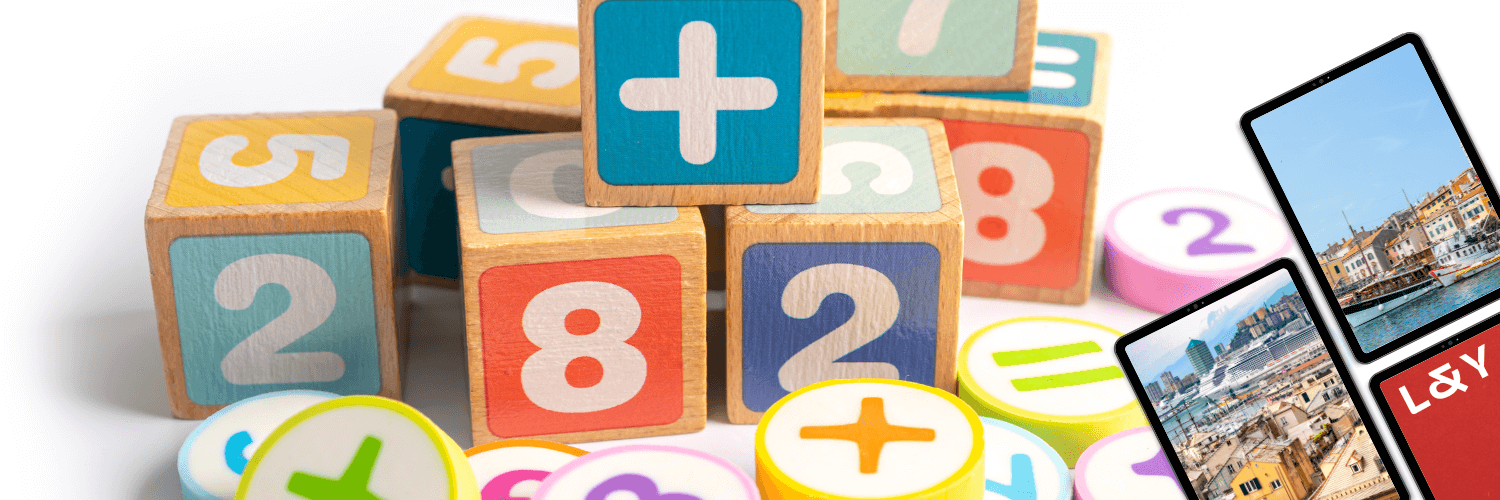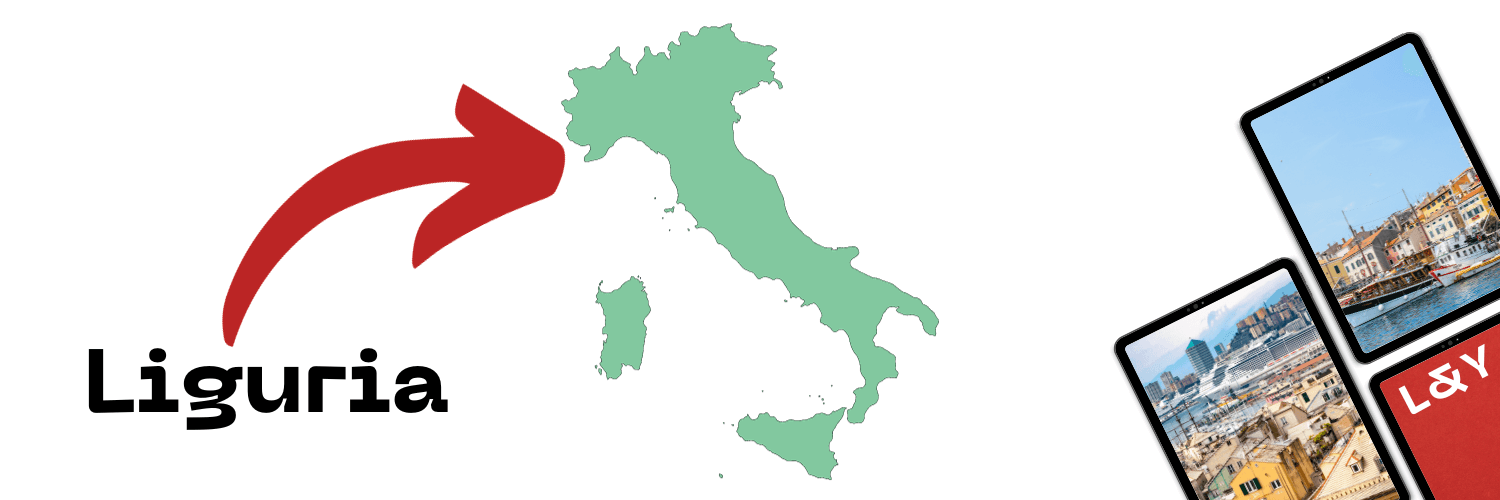9 Key Differences Between Ligurian and Italian
Both Ligurian (also known as Genoese) and Italian are Romance languages as they both derive from Latin. Nevertheless, they belong to different language subgroups. While Italian is an Italo-Dalmatian language, Ligurian is Gallo-Italic. Ligurian is spoken in the region of Liguria in Northern Italy. However, in the past and in the present, there have been communities of Ligurian speakers around the Mediterranean (Sardinia, South East France, Monaco , Corsica, Gibraltar) and beyond (Argentina).
Despite having a rich history and having been one of the most influential languages of the Mediterranean during the Middle Ages, over the last one hundred years, due to the strong presence of the Italian language in the media and education, the number of Ligurian speakers has significantly decreased, and Ligurian is now considered an endangered language.
Even though Italian and Ligurian are similar languages and share many features, as do all Romance languages, there are also significant differences:
Despite having a rich history and having been one of the most influential languages of the Mediterranean during the Middle Ages, over the last one hundred years, due to the strong presence of the Italian language in the media and education, the number of Ligurian speakers has significantly decreased, and Ligurian is now considered an endangered language.
Even though Italian and Ligurian are similar languages and share many features, as do all Romance languages, there are also significant differences:
Difference 1: Definite Articles
Although Ligurian and Italian have more definite articles than English, which only has one (the), Ligurian has less than Italian.
For the masculine singular, Italian has il, lo before a consonant cluster or z and l' before a vowel. In Ligurian, il and lo are o and like Italian, l' is used before a vowel:
o libbro (the book, il libro)
o studente (the student, lo studente)
l'incontro (the meeting, l'incontro)
The plural of il in Italian is i and you use gli if the singular definite article is lo or l'. In Ligurian, the masculine plural definite article is i in all cases:
i libbri (the book, i libri)
i studenti (the student, gli studenti)
i incontri (the meeting, gli incontri)
For the feminine singular, Italian has la and l' before a vowel, whereas the equivalents in Ligurian are a and l'. The plural form in Italian is le and e in Ligurian:
a gamba (the leg, la gamba)
l'isoa (the island, l'isola)
e gambe (the legs, le gambe)
e isoe (the islands, le isole)
With this in mind, the feminine form of nouns ending in -tô is -toa, which differs from Italian, where -tore becomes -trice.
compoxitô → compoxitoa (composer, compositore / compositrice)
pittô → pittoa (painter, pittore / pittrice)
attô → attoa (actor, attore / attrice)
Although Ligurian and Italian have more definite articles than English, which only has one (the), Ligurian has less than Italian.
For the masculine singular, Italian has il, lo before a consonant cluster or z and l' before a vowel. In Ligurian, il and lo are o and like Italian, l' is used before a vowel:
o libbro (the book, il libro)
o studente (the student, lo studente)
l'incontro (the meeting, l'incontro)
The plural of il in Italian is i and you use gli if the singular definite article is lo or l'. In Ligurian, the masculine plural definite article is i in all cases:
i libbri (the book, i libri)
i studenti (the student, gli studenti)
i incontri (the meeting, gli incontri)
For the feminine singular, Italian has la and l' before a vowel, whereas the equivalents in Ligurian are a and l'. The plural form in Italian is le and e in Ligurian:
a gamba (the leg, la gamba)
l'isoa (the island, l'isola)
e gambe (the legs, le gambe)
e isoe (the islands, le isole)
With this in mind, the feminine form of nouns ending in -tô is -toa, which differs from Italian, where -tore becomes -trice.
compoxitô → compoxitoa (composer, compositore / compositrice)
pittô → pittoa (painter, pittore / pittrice)
attô → attoa (actor, attore / attrice)
Difference 2: Different Sounds
Ligurian has two vowel sounds that do not exist in Italian, but they do in French and other Gallo-Italic languages spoken in northern Italy. In Ligurian, these two sounds are represented with an u and eu, the same as in French. The u sound is made by pursing your lips and making an ee sound and the eu sound is very similar to the ir in bird. Here are some words in Ligurian which display these sounds:
neutte (night, notte)
eutto (eight, otto)
zeuggia (Thursday, giovedì)
menuto (minute, minuto)
zugno (June, giugno)
ötunno (autumn, autunno)
In Ligurian, you can also find the scci/e cluster representing a sh sound followed by a ch sound. These two sounds, one after the other, do not feature in Italian:
mescciâ (to mix, mescolare)
sccetto (genuine, schietto)
Ligurian has two vowel sounds that do not exist in Italian, but they do in French and other Gallo-Italic languages spoken in northern Italy. In Ligurian, these two sounds are represented with an u and eu, the same as in French. The u sound is made by pursing your lips and making an ee sound and the eu sound is very similar to the ir in bird. Here are some words in Ligurian which display these sounds:
neutte (night, notte)
eutto (eight, otto)
zeuggia (Thursday, giovedì)
menuto (minute, minuto)
zugno (June, giugno)
ötunno (autumn, autunno)
In Ligurian, you can also find the scci/e cluster representing a sh sound followed by a ch sound. These two sounds, one after the other, do not feature in Italian:
mescciâ (to mix, mescolare)
sccetto (genuine, schietto)
Difference 3: Pluralisation
Both Ligurian and Italian share some of the most basic rules when pluralising words. If a word ends in an -a it becomes -e in the plural and if a masculine word ends in -e / -o, it becomes -i. However, in Ligurian, you have a few extra rules not present in Italian.
In Italian, regardless of whether the word is masculine or feminine, if it ends in an -e, it will become an -i. However, in Ligurian, if a feminine word ends in an -e, it does not change in its plural form (there is an exception; see next paragraph):
frase → frase (phrase/ phrases - frase / frasi)
base → base (base/ bases - base / basi)
However, sometimes, both the consonant and the final vowel change.
Words ending in -se (both masculine and feminine) / -so / -go become -xi:
zeneise → zeneixi (Genoese - genovés, genovesa / genoveses, genovesas)
meise → meixi (month / months - mese / mesi)
naso → naxi (nose / noses - naso / nasi)
amigo → amixi (friend / friends - amico / amici)
If the final letter is an -â it becomes -æ:
artâ → artæ (altar / altars - altare / altari)
familiâ → familiæ (family member / family members - familiare / familiari)
çircolâ → çircolæ (round - circolare / circolari)
If the final letter is an -ô you add an -î to it:
editô → editoî (editor / editors - editore / editori)
professô → professoî (teacher / teachers - professore / professori)
attô → attoî (actor / actors - attore / attori)
Occasionally, you change a vowel within the word instead of modifying the ending. Here are some examples of this:
-an becomes either -en or -oen:
can → chen (dog / dogs - cane / cani)
pan → poen/pen (bread / breads - pane / pani)
-in becomes -oin:
canzon → canzoin (song / songs - canzone / canzoni)
emoçion → emoçioin (emotion / emotions - emozione / emozioni)
Both Ligurian and Italian share some of the most basic rules when pluralising words. If a word ends in an -a it becomes -e in the plural and if a masculine word ends in -e / -o, it becomes -i. However, in Ligurian, you have a few extra rules not present in Italian.
In Italian, regardless of whether the word is masculine or feminine, if it ends in an -e, it will become an -i. However, in Ligurian, if a feminine word ends in an -e, it does not change in its plural form (there is an exception; see next paragraph):
frase → frase (phrase/ phrases - frase / frasi)
base → base (base/ bases - base / basi)
However, sometimes, both the consonant and the final vowel change.
Words ending in -se (both masculine and feminine) / -so / -go become -xi:
zeneise → zeneixi (Genoese - genovés, genovesa / genoveses, genovesas)
meise → meixi (month / months - mese / mesi)
naso → naxi (nose / noses - naso / nasi)
amigo → amixi (friend / friends - amico / amici)
If the final letter is an -â it becomes -æ:
artâ → artæ (altar / altars - altare / altari)
familiâ → familiæ (family member / family members - familiare / familiari)
çircolâ → çircolæ (round - circolare / circolari)
If the final letter is an -ô you add an -î to it:
editô → editoî (editor / editors - editore / editori)
professô → professoî (teacher / teachers - professore / professori)
attô → attoî (actor / actors - attore / attori)
Occasionally, you change a vowel within the word instead of modifying the ending. Here are some examples of this:
-an becomes either -en or -oen:
can → chen (dog / dogs - cane / cani)
pan → poen/pen (bread / breads - pane / pani)
-in becomes -oin:
canzon → canzoin (song / songs - canzone / canzoni)
emoçion → emoçioin (emotion / emotions - emozione / emozioni)
Difference 4: Personal Pronouns
Personal pronouns in Ligurian and Italian are similar, but there are a few highlightable differences. Firstly, Italian has io (I), which derives from the Latin ego , but in Ligurian, you use mi (I), which is an (in)direct and reflexive pronoun in Italian:
mi parlo (I speak, io parlo) vs mi me ciammo (I am called, io mi chiamo)
The second-person singular in Ligurian is ti. When conjugating in Ligurian, you have to add an extra ti:
ti t'ê (you are, tu sei)
ti ti canti (you sing, tu canti)
The same also happens with reflexive verbs:
ti ti te ciammi (you are called, tu ti chiami)
The third-person singular Ligurian is lê as opposed to lui (he) and lei (she) in Italian. Therefore, in Ligurian, to differentiate between a male and a female, you have to include either o (masculine) or a (feminine) before the conjugated verb:
lê o mangia (he eats, lui mangia)
lê a credde (she believes, lei crede)
Both o and a remain in place with reflexive verbs:
lê o se ciamma (he is called, lui si chiama)
lê a se ciamma (she is called, lei si chiama)
Personal pronouns in Ligurian and Italian are similar, but there are a few highlightable differences. Firstly, Italian has io (I), which derives from the Latin ego , but in Ligurian, you use mi (I), which is an (in)direct and reflexive pronoun in Italian:
mi parlo (I speak, io parlo) vs mi me ciammo (I am called, io mi chiamo)
The second-person singular in Ligurian is ti. When conjugating in Ligurian, you have to add an extra ti:
ti t'ê (you are, tu sei)
ti ti canti (you sing, tu canti)
The same also happens with reflexive verbs:
ti ti te ciammi (you are called, tu ti chiami)
The third-person singular Ligurian is lê as opposed to lui (he) and lei (she) in Italian. Therefore, in Ligurian, to differentiate between a male and a female, you have to include either o (masculine) or a (feminine) before the conjugated verb:
lê o mangia (he eats, lui mangia)
lê a credde (she believes, lei crede)
Both o and a remain in place with reflexive verbs:
lê o se ciamma (he is called, lui si chiama)
lê a se ciamma (she is called, lei si chiama)
Difference 5: Vocabulary
Vocabulary can cause some confusion. Many words in Ligurian are at times more similar to French than Italian:
xambon (ham, prosciutto) jambon in French
chinze (fifteen, quindici) quinze in French
cheu (heart, cuore) coeur in French
adresso (address, indirizzo) adresse in French
Others may ressemble Spanish words:
neigro (black, nero) negro in Spanish
amigo (friend, amico) amigo in Spanish
lengua (language, lingua) lengua in Spanish
You may even find some words that Ligurian has borrowed from Arabic:
camallo (dockworker, portuario)
Vocabulary can cause some confusion. Many words in Ligurian are at times more similar to French than Italian:
xambon (ham, prosciutto) jambon in French
chinze (fifteen, quindici) quinze in French
cheu (heart, cuore) coeur in French
adresso (address, indirizzo) adresse in French
Others may ressemble Spanish words:
neigro (black, nero) negro in Spanish
amigo (friend, amico) amigo in Spanish
lengua (language, lingua) lengua in Spanish
You may even find some words that Ligurian has borrowed from Arabic:
camallo (dockworker, portuario)
Difference 6: Not All Letters Are What They Seem
When you read in Ligurian, make sure that when you see an o without an accent, you pronounce it as an Italian u:
raggio (ray, raggio)
bello (beautiful, bello)
fæto (fact, fatto)
Moreover, you pronounce any m before a consonant as ng:
sempre (always, sempre)
tempo (time, tempo)
comba (pigeon, colomba)
In Italian, a single s between two vowels makes an English z sound; this is also the case in Ligurian, except if the preceding vowel contains a diacritic. In this case, you pronounce it as an s.
Z sound:
paise (country, paese)
riso (rice, riso)
reusa (rose, rosa)
S sound:
ëse (to be, essere)
cösa (thing, cosa)
assunnâse (to dream, sognare)
Italian is well known for its double consonants, which are always pronounced (at least in the southern half of Italy). However, in Ligurian, even if there is a double consonant, it is pronounced as a single letter, as happens in English:
anno (year, anno)
assoçiaçion (association, associazione)
contatto (contact, contatto)
When you read in Ligurian, make sure that when you see an o without an accent, you pronounce it as an Italian u:
raggio (ray, raggio)
bello (beautiful, bello)
fæto (fact, fatto)
Moreover, you pronounce any m before a consonant as ng:
sempre (always, sempre)
tempo (time, tempo)
comba (pigeon, colomba)
In Italian, a single s between two vowels makes an English z sound; this is also the case in Ligurian, except if the preceding vowel contains a diacritic. In this case, you pronounce it as an s.
Z sound:
paise (country, paese)
riso (rice, riso)
reusa (rose, rosa)
S sound:
ëse (to be, essere)
cösa (thing, cosa)
assunnâse (to dream, sognare)
Italian is well known for its double consonants, which are always pronounced (at least in the southern half of Italy). However, in Ligurian, even if there is a double consonant, it is pronounced as a single letter, as happens in English:
anno (year, anno)
assoçiaçion (association, associazione)
contatto (contact, contatto)
Difference 7: Two & Three
Numbers in all Romance languages are easily identifiable as, for the most part, they all derive from the same terms in Latin. However, occasionally, some numbers have a feminine and masculine version.
In contrast with Italian, in Ligurian, two numbers have a feminine and masculine version. The number two can be either doi (two, due) in the masculine or doe (two, due) in the feminine. The same occurs with the number three: trei (three, tre) when referring to masculine nouns and træ (three, tre) in the feminine.
Here are some examples of these numbers in context:
doi denti (two teeth, due denti)
doe scheue (two schools, due scuole)
trei giorni (three days, tre giorni)
træ vacche (three cows, tre mucche)
Numbers in all Romance languages are easily identifiable as, for the most part, they all derive from the same terms in Latin. However, occasionally, some numbers have a feminine and masculine version.
In contrast with Italian, in Ligurian, two numbers have a feminine and masculine version. The number two can be either doi (two, due) in the masculine or doe (two, due) in the feminine. The same occurs with the number three: trei (three, tre) when referring to masculine nouns and træ (three, tre) in the feminine.
Here are some examples of these numbers in context:
doi denti (two teeth, due denti)
doe scheue (two schools, due scuole)
trei giorni (three days, tre giorni)
træ vacche (three cows, tre mucche)
Difference 8: Verbs
One of the most recognisable features of verbs in the infinitive form in Italian is their endings: -are, -ire and -ere. In Ligurian, you drop the -re:
cantâ (to sing, cantare)
sentî (to listen, sentire)
vende (to sell, vendere)
Other verbs end in -ei:
avei (to have, avere)
savei (to know, sapere)
voei (to want, volere)
This feature also extends to reflexive verbs:
ciammâse (to be called, chiamarsi)
vestîse (to dress, vestirsi)
sdraiâse (to lie down, sdraiarsi)
One of the most recognisable features of verbs in the infinitive form in Italian is their endings: -are, -ire and -ere. In Ligurian, you drop the -re:
cantâ (to sing, cantare)
sentî (to listen, sentire)
vende (to sell, vendere)
Other verbs end in -ei:
avei (to have, avere)
savei (to know, sapere)
voei (to want, volere)
This feature also extends to reflexive verbs:
ciammâse (to be called, chiamarsi)
vestîse (to dress, vestirsi)
sdraiâse (to lie down, sdraiarsi)
Difference 9: Extra Letters
There are a few letters in Ligurian which do not exist in Italian. Firstly, ç represents an s sound:
çittæ (city, città)
çê (sky, cielo)
çento (hundred, cien)
X in Ligurian is not pronounced ks as in English but represents a French j sound:
noxe (walnut, noce)
croxe (cross, croce)
voxe (voice, voce)
You do not pronounce the ñ as in Spanish but as an ng sound:
luña (moon, luna)
fæña (flour, farina)
mæña (marina, marina)
Finally, æ represents the same sound as the e in the word bet:
veitæ (truth, verità)
ægua (water, acqua)
etæ (age, edad)
There are a few letters in Ligurian which do not exist in Italian. Firstly, ç represents an s sound:
çittæ (city, città)
çê (sky, cielo)
çento (hundred, cien)
X in Ligurian is not pronounced ks as in English but represents a French j sound:
noxe (walnut, noce)
croxe (cross, croce)
voxe (voice, voce)
You do not pronounce the ñ as in Spanish but as an ng sound:
luña (moon, luna)
fæña (flour, farina)
mæña (marina, marina)
Finally, æ represents the same sound as the e in the word bet:
veitæ (truth, verità)
ægua (water, acqua)
etæ (age, edad)
▶ From Italian to Corsican in a Few Simple Steps
▶ From Italian to Maltese in a Few Simple Steps
▶ From Portuguese to Galician in a Few Simple Steps
▶ From Italian to Maltese in a Few Simple Steps
▶ From Portuguese to Galician in a Few Simple Steps







